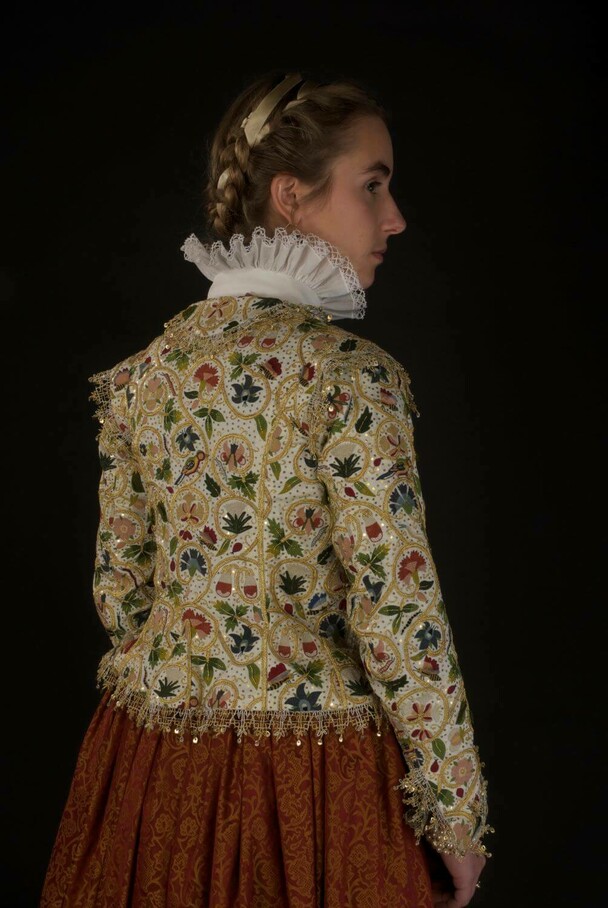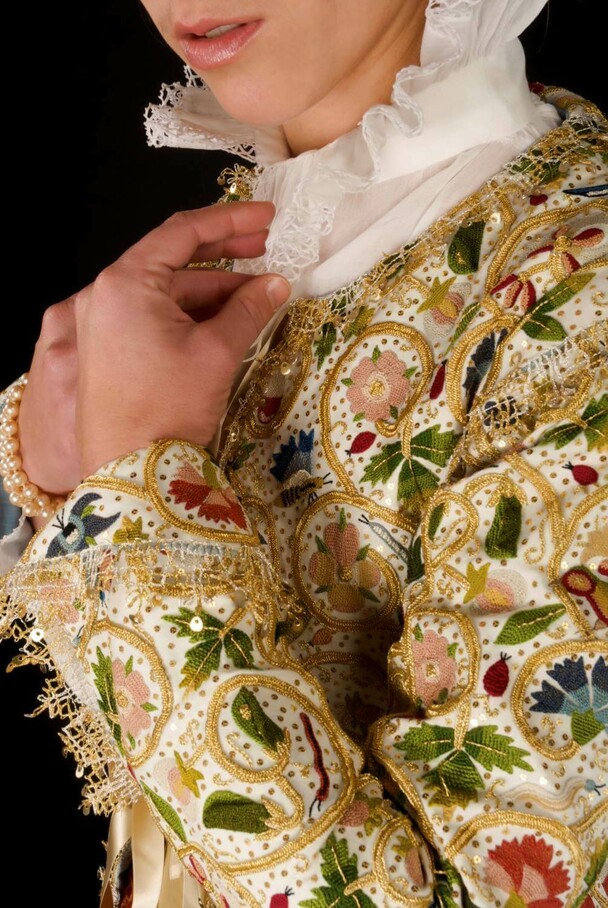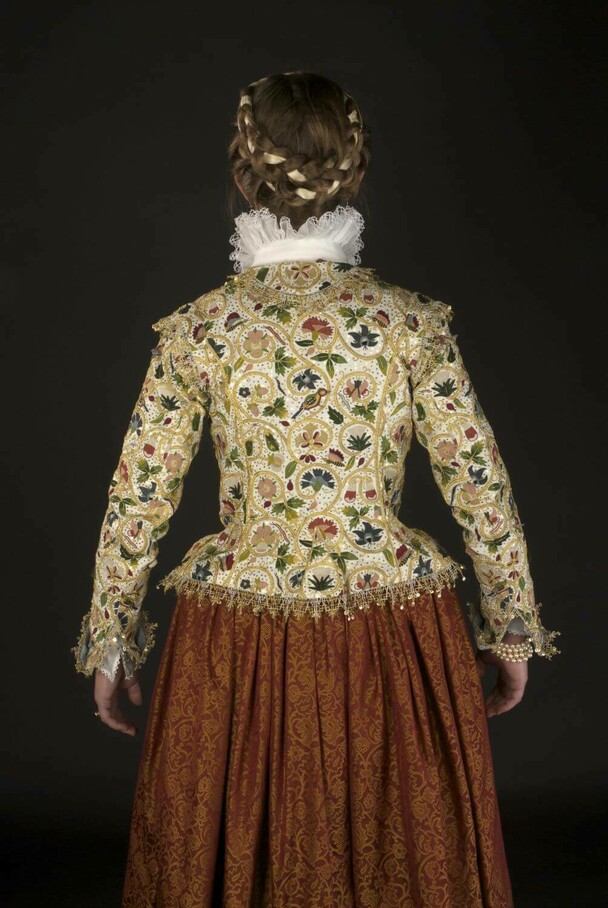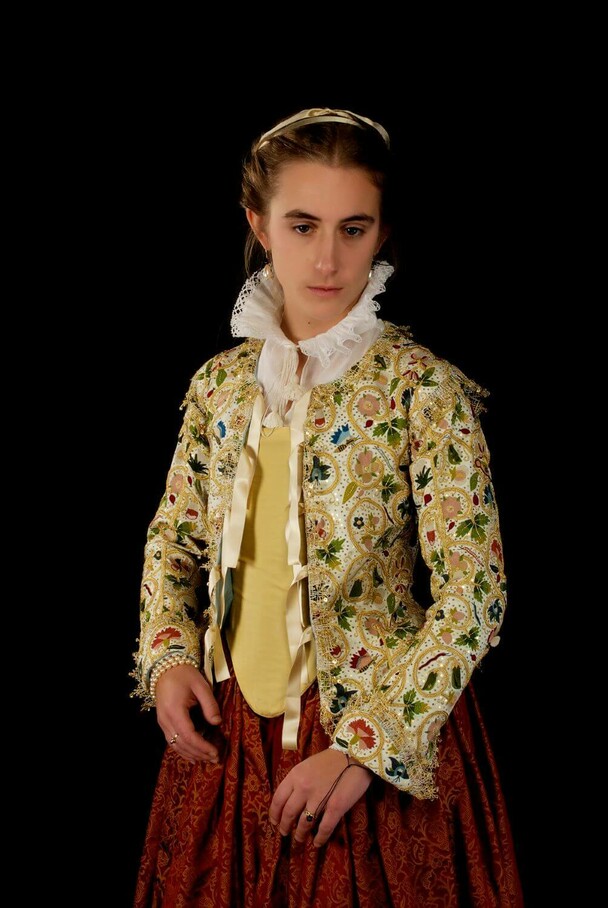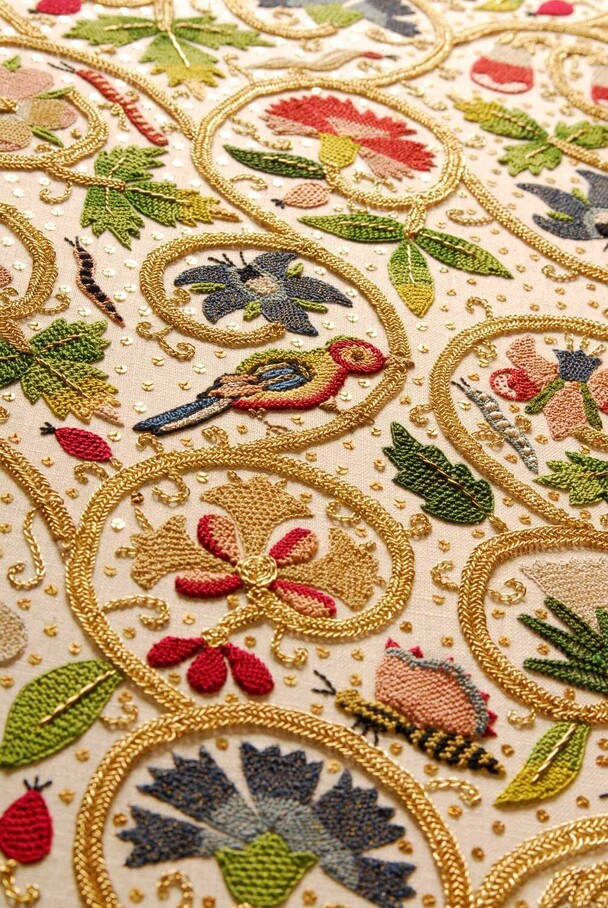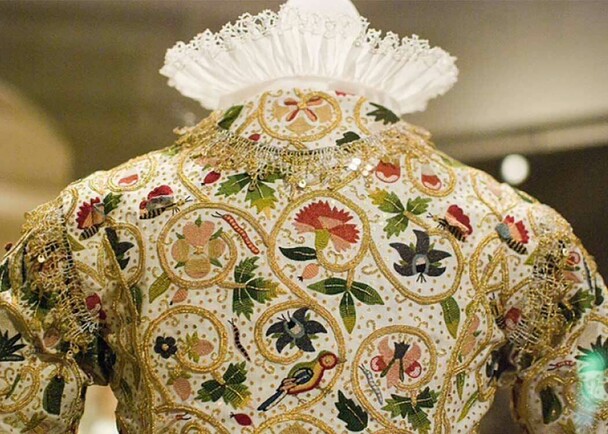An Exceptional Piece of Textile History
A paradise in silk and gold, beautiful and bespoke, the Plimoth Jacket™ stands as an expression of Plimoth Patuxet’s living history at its finest.
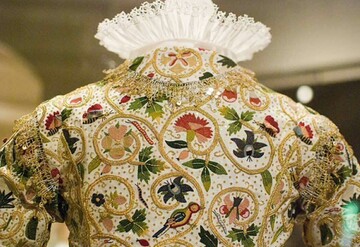
As part of the Museum’s work in recovering the ways of making 17th-century artifacts, Plimoth Patuxet launched an ambitious project to re-create an exceptional piece of textile history. Using only traditional 17th-century methods and materials, the Museum’s Historic Textiles and Clothing department set out to construct, entirely by hand, an embroidered linen jacket. Based on a jacket worn by Margaret Layton more than 400 years ago, the Plimoth Jacket shimmers with 10,000 gilded silver spangles, 4,000 meters of silk thread, and more than 3,000 hours of needlework done by scores of volunteer embroiderers. The exquisite handwork of 21 lace makers is featured in the design. A handwoven, hand-dyed silk lining, and hand-forged hooks-and-eyes complete this masterpiece of textile artistry. The Jacket is an expression of Plimoth Patuxet’s living history at its finest.
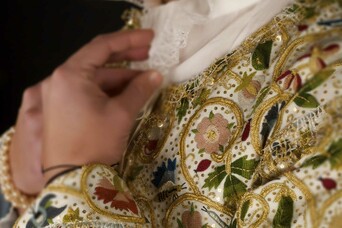
“The Prayse of the Needle”
— by John Taylor, 1631
To all dispersed sorts of arts and trades
I write the needle’s prayse (that never fades).
So long as children shall be got or borne,
So long as garments shall be made or worne,
So long as hemp or flax, or sheep shall bear
Their linen woolen fleeces yeare by yeare,
So long as silk-wormes, with exhausted spoile,
Of their own entrails for man’s gaine shall toyle,
Yea till the world be quite dissolv’d and past,
So long at least, the needles’ use shall last.
Researching Historic Needlework
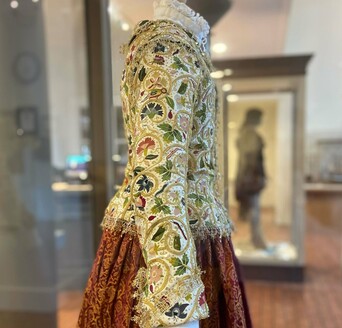
In the early 1600s, England’s privileged class displayed their wealth and position through elaborate, expensive clothes and accessories. Particularly spectacular outfits were recorded in portraits. During this period, linen jackets embroidered with colored silk and metal threads were the fashion for women of the upper class (those wealthier than the Plymouth colonists but below the royalty/aristocracy). These jackets were popular between c.1590 – 1630. Not only do they appear in a number of portraits, but there are also several extant examples of the jackets themselves in museum collections.
After surveying a variety of collections, attention focused on two jackets at the Victoria & Albert Museum (V&A) in London, with a very similar example in the collection of The Met. Fortunately, the jacket worn by Margaret Layton in a portrait of c.1627 had been studied by Janet Arnold, and a pattern for it was printed in her 1985 book, Patterns of Fashion: The Cut and Construction of Clothes for Men and Women c.1560-1620. The embroidery on the second jacket from the V&A included a large variety of motifs in a pleasing color palette. It was decided to combine the embroidery of the latter with the drafted pattern of the former. Susan North, Curator of Seventeenth and Eighteenth Century Fashion at the V&A, was involved in this, going beyond the call of duty by taking beautiful, detailed photos of the second jacket to draw out the embroidery design.
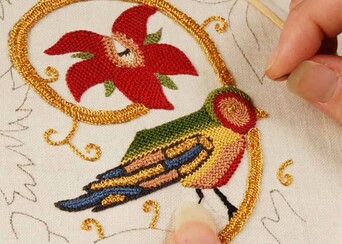
An Excerpt from“Margaret Layton’s Jacket”
— by Steve Barker
Here, though, is your jacket –
its spangled braille
asking to be touched,
its birds and bay leaves
perched and poised
in the present air.
The Pattern
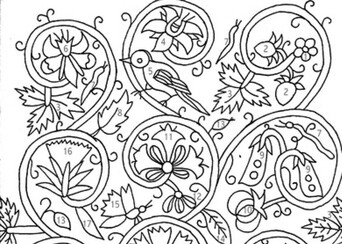
Using detailed photographs of both the jacket and matching panel, the original design of the embroidery was determined. The final pattern contained 27 motifs. The design was then copied onto the paper pattern for the waistcoat, and each piece was checked against the original for pattern deviations. The pattern pieces were then laid out on fine linen fabric, and the embroidery design was traced onto each piece of linen with a special pen.
The Materials
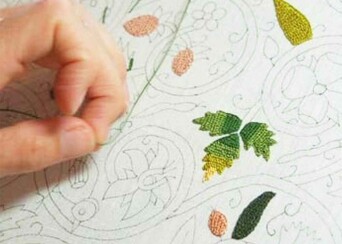
Choosing appropriate colors was important. It took weeks to find silk threads that would accurately reproduce the colors of the original embroidery. Some of the materials themselves had to be reproduced, as various types of thread used in the 1620s are no longer made. Specialists created gold and silver threads just for the project, and the needles, handmade in Japan, were meticulously sourced.
The Process
As part of the planning stage, the head embroiderer conducted a time trial to estimate how long it would take to complete the jacket. One of every type of design had to be stitched to create the instructions for the embroidery volunteers. Sample kits were created for practice and purchase, and proceeds supported the project. Stitching began in July 2007, and throughout the process volunteers continued to check their work against the original jackets and the plans for both color and composition control. The silk embroidery was completed in June 2008; however, the Jacket was far from completion. Work then began on the gold vines, and the spangles as well as round sequins, known as “oes” in the 17th century.
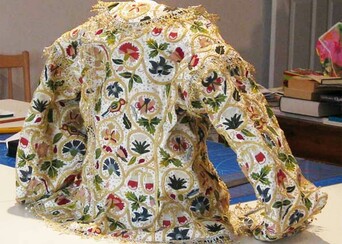
The majority of the work on the Jacket took place at Plimoth Patuxet, however, on occasion the project traveled to other locations. By August 2009, the needlework was completed. The project involved more than 3,700 hours of handwork and months of research and preparation.
The Construction
Before the final Jacket was constructed, a full-size model was made. Then, each piece was carefully cut off the embroidery frame. The story of the jacket and how it came to be was written on the seam allowance, to ensure its story was sewn into history. After all the pieces of the Jacket had been stitched together, the seams were covered with plaited braid before the lining was incorporated. The completed Jacket made its debut at Plimoth Patuxet on December 10, 2009, nearly 15 years ago. Soon after, it traveled to Winterthur where it was featured in an exhibition on the methods and materials used in historic needlework.
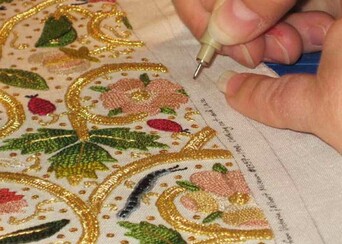
An Excerpt from “Couture”
— by Mark Doty
Nothing needs to be this lavish.
Even the words I’d choose
for these leaves;
intricate, stippled, foxed,
tortoise, mottled, splotched
-jeweled adjectives…
dusky, flattering rose.
The world’s made fabulous
by fabulous clothes.
